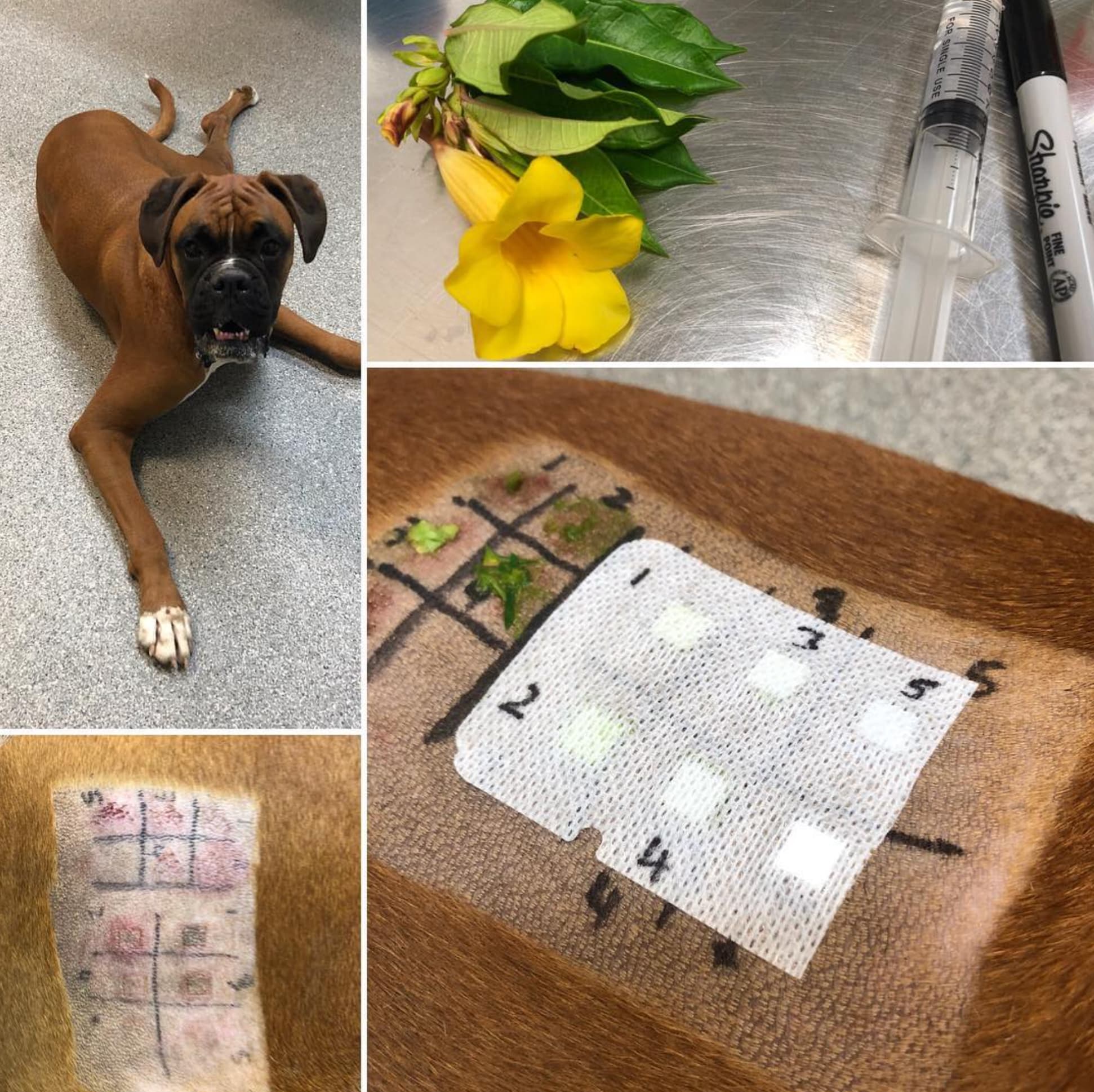Monitoring and caring for your pet’s skin is vital for their overall health & wellbeing. While we understand the reasons why we need to look after our own skin, there are just as many reasons to ensure our beloved fur friends are given the same attention in this respect.
While it’s convenient to assume their thick coat of fur can protect them from factors like the sun’s UV rays, it can also have the adverse effect of masking what could really be going on.
With the help of Dermatologist Vet, Dr Evie Knight, we take a deep dive into the importance of caring for the skin and coat of dogs & cats.
1. Why is it important to look after the skin and coat of cats and dogs?
Our furry friends provide us with unconditional love and companionship. In return, it’s our responsibility as pet owners to ensure their well-being, and that includes taking care of their skin and coat.
While it may seem like a superficial concern (pun intended), maintaining a healthy skin and coat for your pets is far more than just aesthetics; it’s a crucial aspect of their overall health and happiness.
The skin is the largest organ in the body, and it serves as the first line of defence against external threats for both humans and animals. For our pets, their skin plays a vital role in protecting them from various environmental factors such as UV radiation, pathogens, and allergens. A healthy skin barrier is essential to prevent infections (bacterial and fungal), to minimise the risk of allergies, and to keep the skin comfortable and free from irritation.
Every pet is different, and their skin and coat needs are unique.
2. What are the most common skin conditions that impact cats and dogs?
Cats and dogs frequently develop skin conditions, the symptoms of which can range from mildly annoying to debilitating. The most common skin conditions affecting cats and dogs include allergies (foods, airborne pollens and dust mites, and contact allergens), infections (bacterial, fungal, and parasites), and immune mediated diseases (discoid lupus erythematosus and pemphigus foliaceus). Unfortunately, cats and dogs also suffer from skin cancers which may be benign or malignant (haemangiomas, cutaneous lymphoma, and mast cell tumours, to name a few).
It is important to keep in mind that many skin conditions share similar symptoms such as itching, redness and hair loss. It is crucial to consult with your local veterinarian or dermatology specialist for an accurate diagnosis and appropriate treatment. It can be impossible to determine the specific cause without performing some tests. Your vet may suggest one or more of the following tests:
- Cytology – staining and examining skin cells and organisms under the microscope
- Trichography – examining fur samples under the microscope
- Histopathology – sending biopsy samples of skin for examination and assessment by a pathologist at the laboratory
- Allergy testing – intradermal injections, patch testing, blood tests and elimination diets
Below is an allergy patch test conducted on a dog by Dr Evie.

3. I have heard about Apoquel from other pet owners and that there is a new chewable tablet launching in September 2023. Is it the same and how will I know if my dog may need it prescribed?
Apoquel is a targeted anti-itch treatment often prescribed to relieve the symptom of itch in dogs with allergies or other causes of itchy skin. It acts quickly and has few side effects, so it is often used by general practitioner vets as a first line treatment. More recently a new chewable formulation has been developed, and this may be a game-changer for those cheeky canines who won’t take tablets. Either of these options may be used interchangeably, but it is worth considering that the chewable tablets are flavoured so they are not suitable for dogs on an elimination diet trial.
It must be emphasised that itch is just a symptom of an underlying condition, so if the problem recurs once Apoquel is ceased, a visit to a dermatologist is warranted to get an accurate diagnosis and break the itch cycle for good.
4. What do you suggest for basic skin care for pets?
Every pet is different, and their skin and coat needs are unique. If there was a simple routine that worked for all pets I would be out of a job! With that said, there are some basic yet effective things you can do to minimise the development of skin and coat problems.
1. Regular brushing:
Dogs and cats of all breeds (except the hairless kind!) benefit from brushing to detangle and to remove undercoat. Longer coated breeds may require brushing up to daily, while shorter haired breeds may only need brushing once a week.
2. Bathing:
Using a gentle pet shampoo (eg. Aloveen), pets may be bathed up to once weekly. Most pets do not require bathing this often and once every 2-4 weeks may suffice. Bathing pets too often can strip the skin and coat of the natural oils, resulting in dry and irritated skin. Equally, if your pet has developed a skin problem, bathing more frequently than once per week may be required, usually with a medicated shampoo (eg. Mediderm). While it is possible to give cats a bath, it is worth noting that most feline companions tend to strongly disapprove of the suggestion. So, if you choose to bathe them, be prepared for potential resistance!
3. Flea and tick control:
Flea allergy dermatitis can be severe, and the number of fleas required to cause this is quite low. In fact, you may never see a flea, especially in cats who are enthusiastic groomers. Ticks on the other hand are deadly, so prevention is far better than cure. Numerous convenient and effective flea and tick products are available with the frequency of administration ranging from once per month to once every three months. A discussion with your local vet or vet nurse will help to determine the best option for your pet.
4. Nutrition:
We’ve all had a conversation with someone who ardently advocates the food they feed to their pet to everyone they know. Once again, every pet is unique and what proves effective for one may not necessarily be the most suitable option for another. Raw feeding can work well for some dogs and cats, while others can become seriously ill. Equally, dry foods developed to support skin health may significantly improve the condition of your pet’s skin, however, an animal who suffers from dietary intolerances or allergies will not thrive if the food in question contains ingredients to which they have adverse reactions. Irrespective of food preference, the key factors are that it is well balanced and that it is compatible with your pet’s unique needs.
5. Topical products:
In pets with particularly dry skin, non-scented oils such as QV or Alpha Keri bath oil may be diluted (1:100) and rinsed through the coat, after shampooing. For those with normal or dry skin, after towel drying, it is beneficial to apply a leave on conditioner specifically formulated for the pH of your pet’s skin as this will help to moisturise their skin and coat. For pets with oily or dry skin, the barrier function can also be improved with Essential 6 oils applied topically. This can even help to significantly reduce bad odours!


About the Author:
Dr Evie Knight BVSc MANZCVS FANZCVS DipACVD graduated from the University of Melbourne in 2010. She has worked in general practice, as an emergency vet and more recently in specialist dermatology referral practice. Dr Knight has achieved the notable distinction of being a double boarded specialist in the field of veterinary dermatology, holding certifications from both the Australian and New Zealand College of Veterinary Scientists (ANZCVS) and the American College of Veterinary Dermatology (ACVD).
She is proudly embarking on a new venture, with her business Animal Dermatology Specialist launching soon. Located in the Gold Coast, Australia, she can be reached @animal_derm on Instagram, and AnimalDermSpecialist on Facebook. She is passionate about bringing comfort to animals grappling with chronic skin and ear conditions.
